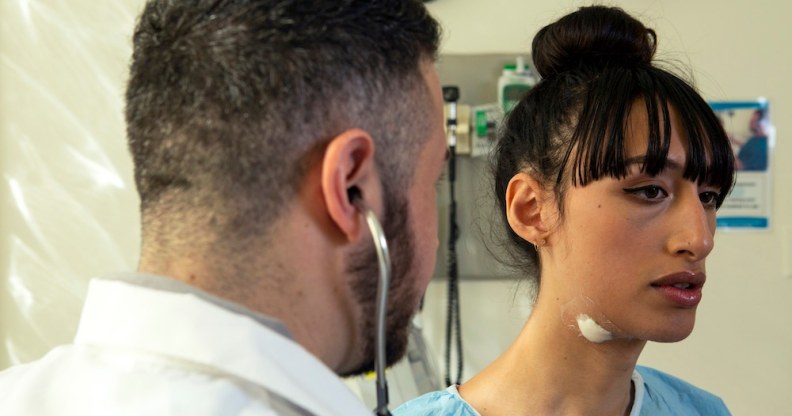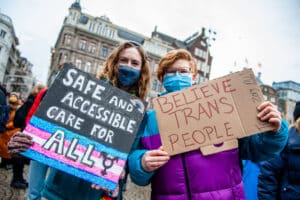Government ignored evidence on trans women’s needs when drafting landmark health strategy

A trans woman in a hospital gown. (Zackary Drucker/ The Gender Spectrum Collection)
The government’s first-ever Women’s Health Strategy consciously excluded trans women, despite receiving evidence of risks related to cancer care, physical, mental and sexual health services.
The 10-year strategy was unveiled on 20 July, with a flagship promise to scrap discriminatory rules on fertility treatment for same-sex couples.
It marks a huge leap forward for inclusive healthcare in the UK, but it has also faced criticism from the LGBTQ+ community. Trans women were not mentioned once in the 125-page Women’s Health Strategy, although trans men and non-binary folk were mentioned in one paragraph.
Those involved in the development of the strategy have suggested that this exclusion was a conscious choice.
After the Department for Health and Social Care issued a call for evidence in April, multiple parties came forward, including members of NHS England, to explain the inequalities facing trans women.
After the strategy’s release, Lizzie Streeter, national LGBT programme manager for NHS England, tweeted: “Incredibly disappointed to see that none of the suggestions our team worked on to ensure that the DHSC Women’s Health Strategy published today is inclusive of trans women have been included.”
Incredibly disappointed to see that none of the suggestions our team worked on to ensure that the @DHSCgovuk Women’s Health Strategy published today is inclusive of trans women have been included.
— Lizzie Streeter (@lizzietweeter) July 20, 2022
Government was given evidence on need for trans-inclusive cancer screenings and fertility care
In a submission to the department’s call for evidence, seen by PinkNews, the trans rights organisation TransActual pointed out the risks faced by some trans women and non-binary people assigned male at birth, as well as trans people that have gynaecological anatomy.
We also submitted a response to the consultation and it’s a real shame that the DHSC were so selective with which evidence they listened to. https://t.co/ZZOhDUa8Tf— Trans Actual (@TransActualUK) July 20, 2022
The organisation’s detailed 10-page submission noted that the inquiry’s remit included aspects of healthcare pertinent to some trans men and non-binary people, and as such its submission would do the same.
“We would wholeheartedly support any moves to remove unnecessarily gendered language from consultations on aspects of healthcare that impact trans men and non-binary people in addition to women,” TransActual wrote.
“This is something we wish to see in addition to consultation and conversations about issues that do specifically impact women and women alone – overcoming the impact of sexism in medicine is crucial.”
The submission addressed the many barriers faced by all trans people, for example the barriers to accessing gender-affirming care like hormones and surgeries, as well as issues of services not using inclusive language or being outwardly trans-affirming.
For trans men and non-binary people assigned female at birth, TransActual highlighted the need for inclusion in cervical and breast cancer screening, as well as clear information on fertility and pregnancy for those who are able to get pregnant, even if they are not women.
Along with noting inequalities faced by trans women who need to access sexual health services and prostate and breast cancer care and screening, the organisation also dedicated an entire section of its submission to trans women’s mental health needs.
TransActual said: “Whilst some of the barriers to healthcare are similar for trans women and those who aren’t trans, there are of course differences… Trans women are disproportionately impacted by poor mental health.”
It added: “The National LGBT Survey reported that 30 per cent of trans women had accessed mental health services, with 12 per cent trying unsuccessfully to access them. 73 per cent of trans women found it ‘not easy’ to access mental health services.
“Common barriers to accessing mental health services were waiting times, anxiety or embarrassment, having an unsupportive GP or the GP not knowing where to refer.
“As previously mentioned, there is a need to ensure that GPs and other healthcare staff are trained appropriately in the needs of trans people and in strategies to help them to overcome barriers to accessing mental health support.”
Attending to the diversity of women’s experiences will improve every woman’s experience of healthcare
Excluding trans women from the Women’s Health Strategy doesn’t just fail trans women, it fails all women, explained Dr Ben Vincent, co-ordinator of the Trans Learning Partnership at the queer welfare charity Spectra.
“We should be talking more about menstruation, we should be talking more about menopause, we should be talking more about the details of gynaecological health or breast cancer, or what it means to age as a woman, so on and so forth,” they told PinkNews.
“But we need to do so in a framework that has nuance, and therefore works for everyone… I believe very strongly that when the needs of the most vulnerably intersected groups are attended to carefully, everyone benefits.
“We see this in all kinds of contexts. If you were to attend to making a service accessible for, say, vulnerable migrant women of colour, you would probably find that women who aren’t also in those demographic boxes are finding the service more nuanced, or easy to access, or a bit more sensitive.”
For example, the single paragraph in the Women’s Health Strategy that mentions trans men and non-binary people needing gynaecological care commits to creating “a new NHS Cervical Screening Management System” which could allow GPs or sexual health providers to opt-in eligible trans men and non-binary people and opt-out those ineligible. Currently, anybody registered with their GP as male must request their own screenings, according to the NHS.
This means trans men and non-binary people in need of screenings are forced to take on an “administrative burden that other people do not have to face”, said Vincent.
Changes like this are “good and important”, said Vincent, and the new system will benefit a wide range of people.
“If we think about women who do not have that physiology, whether they are trans or not, it could be quite distressing to be reminded [of the need for a screening].
“For example, you’re a cisgender woman who’s had a radical hysterectomy, and is absolutely distraught that you are now unable to have children. [If] you get this thing telling you you need your cervix checking and you don’t have one, that could be salt in the wounds for a not insignificant number of people.”
They added: “If one thinks about how one talks about the needs of women in a way that also attends to trans women, everyone will actually benefit from that, because you’ll be approaching your conceptualisation in a way that is sensitive to a greater diversity of women’s experiences.”

Two people hold placards during a demonstration for better transgender health care in Amsterdam. (NurPhoto/ Romy Arroyo Fernandez)
Often, said Vincent, trans people are excluded from from such healthcare initiatives and strategies because of fear, confusion, and the interpretation that healthcare for trans folk is some kind of separate category that cannot be interwoven into all aspect of care for all people.
They said: “People start getting hung up on these big questions of, ‘What makes a woman? What is a woman?’ This makes people very anxious, and they often go, ‘That’s not the job we’ve been tasked to do… But of course, you don’t need to do that.
“You don’t need to nail down some kind of essential thing which will include every woman, and not include every person who isn’t a woman.
“But one can recognise that those people who move through the world as women, are positioned by other people as women, call themselves women, will experience certain things that people who don’t won’t.”
Vincent notes that the Women’s Health Strategy not only excludes trans women, it also does not mention the concept of misogyny or bodily autonomy as a political function, concepts that are hugely important to understanding women’s healthcare.
They are “relevant in terms of trans women because of the incredible failure of the NHS to provide transition related care, the wait times for gender identity clinics, or even the very fact that one has to pass through a gender identity clinic to access hormones when those are routinely prescribed and made available in primary care contexts”.
This also has a “wider implication for the politics of women’s bodily autonomy, when we’re thinking about things like medical interventions that relate to fertility“.
Vincent continued: “Thinking about what sensitive and inclusive care that forefronts the bodily autonomy of women, you’re not going to do that right if you’re not attending to your most vulnerable women… Trans women face a wide range of serious and specific social detriments, and that needs attention. Doing so will help all women.
“I think that’s not a controversial statement. Even if there are many social actors who would like to construct it as a controversial statement.”
Fertility expert involved in strategy says trans inclusion should be next step in ongoing work
Kayleigh Hartigan, founder of fertility platform, Fertility Mapper, and who has also worked with the World Health Organization, the NHS and the Department of Health, was tasked with setting up the all-women advisory panel for the development of the strategy.
Speaking to PinkNews, she described the incredible impact that equal access to IVF will have, from lowering the huge cost barriers faced by same-sex couples, to reducing the number of families forced to go through unofficial routes like Facebook groups to access sperm donation.
“I think what’s super exciting about this is if you look at the kind of narrative associated with fertility treatment and assisted reproduction, it’s often one of failure and hurt,” she said.
“I think by creating this opportunity, or creating what should have happened previously, it was sort of shifting the dynamic – how do we support women and people to create families in a way that they want to?”
But Hartigan was non-committal when asked about criticism of the strategy’s exclusion of trans women.
She said: “Do I think it [trans women] should have been included? Probably.
“And is it something they should focus on as part of the next wave of things they’re doing? Absolutely.
“There’s always a challenge when you publish a document, because it creates a line in the sand, a moment in time. But it’s not like it’s the end of the project… It went to press, and the next day, they all got up and continued working.”
She added: “I would strongly encourage them to consider that, as a really, really crucial thing that’s addressed over the next few months, as they start to think about the next phases of the work.”
A spokesperson for the the Department of Health and Social Care told PinkNews:A “The aim of the Women’s Health Strategy’s is to improve the health of all women and girls.
“We recognise that people who are transgender, non-binary, or have variations in sex characteristics will have specific needs and experiences and it is a cornerstone of the NHS that it provides services to those who need them with no discrimination.”

